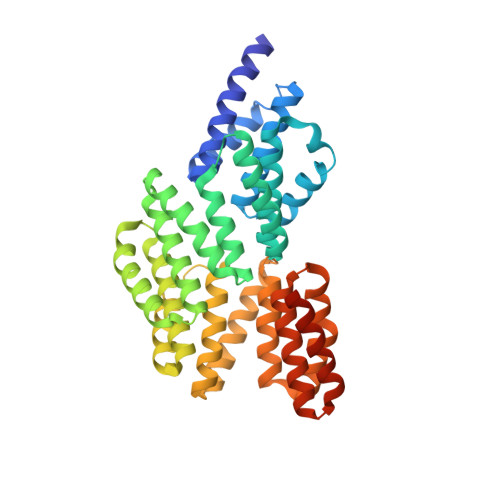How Quorum Sensing Connects Sporulation to Necrotrophism in Bacillus thuringiensis.
Perchat, S., Talagas, A., Poncet, S., Lazar, N., Li de la Sierra-Gallay, I., Gohar, M., Lereclus, D., Nessler, S.(2016) PLoS Pathog 12: e1005779-e1005779
- PubMed: 27483473
- DOI: https://doi.org/10.1371/journal.ppat.1005779
- Primary Citation of Related Structures:
5DBK - PubMed Abstract:
Bacteria use quorum sensing to coordinate adaptation properties, cell fate or commitment to sporulation. The infectious cycle of Bacillus thuringiensis in the insect host is a powerful model to investigate the role of quorum sensing in natural conditions. It is tuned by communication systems regulators belonging to the RNPP family and directly regulated by re-internalized signaling peptides. One such RNPP regulator, NprR, acts in the presence of its cognate signaling peptide NprX as a transcription factor, regulating a set of genes involved in the survival of these bacteria in the insect cadaver. Here, we demonstrate that, in the absence of NprX and independently of its transcriptional activator function, NprR negatively controls sporulation. NprR inhibits expression of Spo0A-regulated genes by preventing the KinA-dependent phosphorylation of the phosphotransferase Spo0F, thus delaying initiation of the sporulation process. This NprR function displays striking similarities with the Rap proteins, which also belong to the RNPP family, but are devoid of DNA-binding domain and indirectly control gene expression via protein-protein interactions in Bacilli. Conservation of the Rap residues directly interacting with Spo0F further suggests a common inhibition of the sporulation phosphorelay. The crystal structure of apo NprR confirms that NprR displays a highly flexible Rap-like structure. We propose a molecular regulatory mechanism in which key residues of the bifunctional regulator NprR are directly and alternatively involved in its two functions. NprX binding switches NprR from a dimeric inhibitor of sporulation to a tetrameric transcriptional activator involved in the necrotrophic lifestyle of B. thuringiensis. NprR thus tightly coordinates sporulation and necrotrophism, ensuring survival and dissemination of the bacteria during host infection.
Organizational Affiliation:
Micalis Institute, INRA, AgroParisTech, Université Paris-Saclay, Jouy-en-Josas, France.














